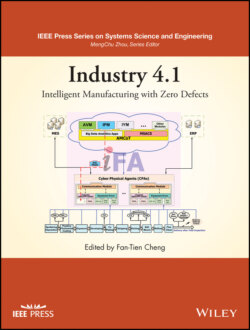Читать книгу Industry 4.1 - Группа авторов - Страница 68
2.4.1 Detrending of the Thermal Effect in Strain Gauge Data
ОглавлениеTo detect force and torque during machining, a smart tool holder is developed and used in an CNC milling machine. When several corresponding gauges are attached to the holder, a strain gauge can be used to detect variation in the bending and torsion of the tool holder based on the proportional ratio of the resistance to the length of the stain gauge. As illustrated in Figure 2.23, the values of strain on the tool holder are sensed and detected by Wheatstone bridges, digitized using an ADC, processed via a microprocessor, and transmitted to an edge computer by using the message queuing telemetry transport (MQTT) protocol through a Wi‐Fi module.
Figure 2.23 Using a smart tool holder to detect tool state.
The edge computer located near the CNC machine receives and processes strain values and issues tool events to the controller when tool breakage is detected or tool’s RUL is short. A tool holder is stiff enough to enable clamping of a tool under various machining conditions and lead to tiny machining variation in the length and resistance of a strain gauge. Although a high‐gauge‐factor sensor is employed, a length difference (<1 μm) in a tool holder can be detected during machining. However, the strain gauge appears to have considerable thermal variations even in a stationary state. Thus, one challenge is how the thermal effect in strain‐gauge data can be removed to derive effective strain values; the details are described in [17] via IEEE DataPort.
For example, Figure 2.24a depicts raw signals collected during machining for 2.8 s (sampling rate of 10 kHz). Because of the high heat capacity of a real machine, the thermal variation can be assumed to be constant within a short period such as 5 s. After applying the wavelet de‐noising method with five levels (denoted DB5), the thermal trend can be derived as illustrated in Figure 2.24b. Then, the de‐trended data can be obtained by subtracting the thermal trend from the raw data; the result is depicted in Figure 2.24c.
Figure 2.24 Detrending of the thermal effect in strain‐gauge data: (a) before detrending; (b) the thermal trend; (c) after detrending.
The thermal trend in the raw signal can be removed and normalized to the same criterion by subtracting the mean value. As shown in Figure 2.25, the darker and lighter lines represent the signals before and after de‐noising using the wavelet mother function DB3, respectively. The signals collected during machining imply that the signals contain the dry‐run and tool‐use periods.
Figure 2.25 De‐noising signals to highlight differences between dry‐run and tool‐use periods.
By comparing with the values measured during the dry‐run period (range ± 0.035 mV), the values measured during tool‐use can be filtered from the background noise and derived in the range of ±0.083 mV. After de‐trending and de‐noising the raw data, the ratio between the dry‐run and tool‐use signals can be improved from 1 to 2.37, which makes the extraction of effective features for modeling considerably easier.
